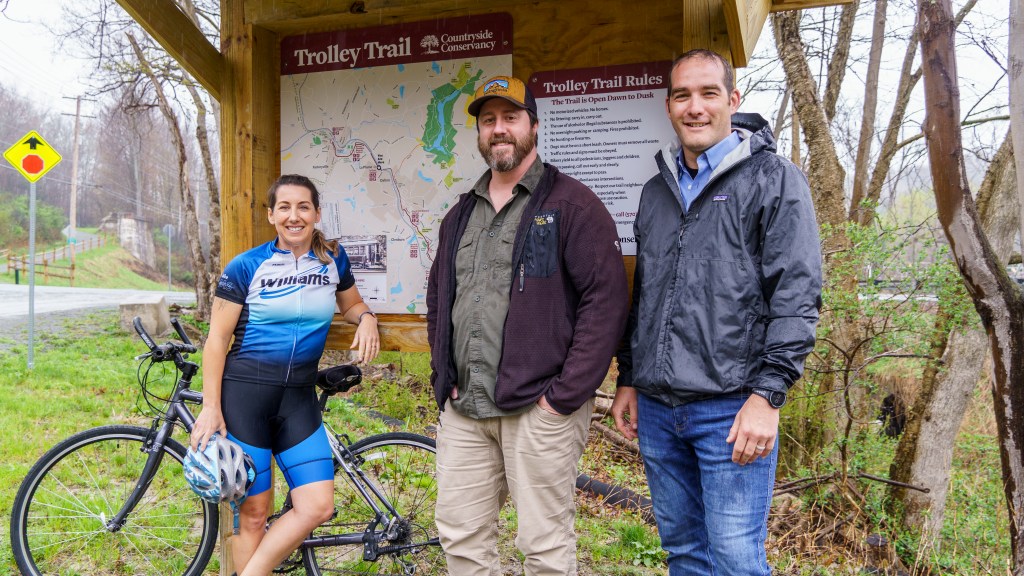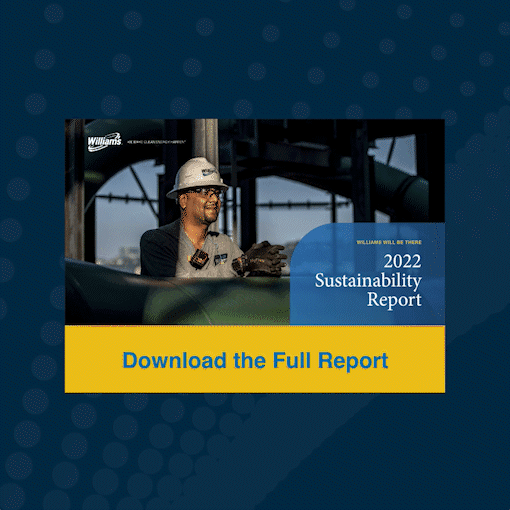Environmental stewardship is core to Williams’ operations. We are increasing our focus on safeguarding biodiversity and using land responsibly while advancing the clean energy economy. Williams strives to preserve the environment for future generations by avoiding, minimizing and mitigating potential impacts on biodiversity and land during the routing, siting, construction, remediation, and retirement of pipelines and facilities. During construction activities, Williams goes beyond regulatory requirements and employs an Environmental Inspector or designated Environmental Responsible Person to oversee environmental compliance of project plans and permits. Williams began implementing this standard across all Williams operating areas in late 2022 and anticipates the integration of this standard into the Williams Integrated Management System for full execution in 2023.
Biodiversity Management
Williams’ biodiversity practices are governed by company-driven policies and local, state and federal regulations. Our approach to protecting the health of our local ecosystems reflects the key principles of the International Finance Corporation’s environmental and social sustainability performance standards. For both onshore and offshore operations, we apply an adaptive mitigation hierarchy to “avoid, minimize, restore, and offset” potential impacts on sensitive land and aquatic ecosystems during project development and execution.
Williams’ potential to affect biodiversity mainly occurs during the construction of our pipelines. In the early stages of project development, we conduct geographic information system (GIS) analyses, computer-based reviews and site-specific surveys to pinpoint sensitive environmental, cultural and historic areas. Our preliminary project analysis seeks to identify and protect areas of High Conservation Value (HCV) from the impacts of construction and prevent land use changes within natural habitats. We pay special attention to streams and wetlands; rare, threatened or endangered species; historic properties; and culturally important sites, including those important to indigenous peoples.
We also seek to understand interconnections (or interdependencies) between natural resources and local communities. This contextual information is valuable for decision making and long-term success of restoration and stewardship efforts. We use the outputs of the GIS analyses, combined with stakeholder feedback, to proactively develop natural resource management strategies that address any potential adverse effects from construction and operations.

Sustainable development of new projects involves responsibly managing natural resources and preserving ecosystem services in the process. When feasible, we design projects that use or run parallel to existing rights-of-way to minimize habitat fragmentation and avoid areas with high biodiversity. We develop and execute new projects in compliance with all applicable regulations, including those issued or enforced by the U.S. Fish and Wildlife Service, Bureau of Land Management, National Oceanic and Atmospheric Administration Fisheries, U.S. Army Corps of Engineers and the Federal Energy Regulatory Commission. Our stakeholder engagement and actions related to biodiversity help us maintain collaborative relationships with landowners, communities and regulators. This supports our ability to manage our assets effectively and develop new projects responsibly.
In 2022, 12% of land owned, leased and operated by Williams was within or near areas of protected conservation status or endangered species habitat, as determined by the International Union for Conservation of Nature (IUCN); Ramsar Wetlands of International Importance; United Nations Educational, Scientific and Cultural Organization World Heritage Sites; and U.S. Fish and Wildlife Service. The chart to the left shows the number of IUCN red-listed species in 2022 within the counties where Williams operates.
Williams works closely with state and federal agencies to minimize impacts if we cannot avoid sensitive biodiversity areas by rerouting projects during the design phase. We evaluate projects early in the development stages to identify potential resource impacts and permitting feasibility before further considering executing on a proposed project. In addition to working with permitting agencies, Williams also collaborates with interest groups, biodiversity and land mapping experts, community organizations and land management agencies to develop appropriate impact minimization, restoration and offset plans. Standard minimization measures include following seasonal land clearing restrictions, reducing construction footprints and implementing specialized construction methods. In 2022, we continued our engagement with companies that provide GIS data services to ensure we have the most accurately available public land use data in our Environment, Health and Safety Master Asset Viewer system. This data allows our team to properly minimize adverse effects on biodiversity. Williams recognizes that right-of-way clearing and maintenance can have a long-term impact on trees since they cannot be replaced over the pipeline post construction due to pipeline integrity and monitoring reasons. We value forests for their important contribution to ecological biodiversity and climate by serving as nature’s carbon sinks. Our commitment to climate action extends to responsible management of this valuable resource. Whenever feasible, our project routing aims to avoid construction through forested areas and reduce the number of trees removed during clearing. Williams also supports reforestation and habitat restoration through corporate giving and partnerships with NGOs, such as the Arbor Day Foundation. In honor of the 50th Anniversary of the Arbor Day Foundation in 2022, Williams supported the Foundation to replant 50,000 longleaf pine trees in North Carolina, South Carolina and Louisiana. The longleaf pine tree currently covers a small fraction of its original range, and the loss of its ecosystem has been detrimental to the nearly 600 animal and plant species that depend on it. Reviving the species will help reduce forest fragmentation and give a home to endangered wildlife like the red-cockaded woodpecker, indigo snake and gopher tortoise. It will also reduce erosion due to the species’ ability to grow in sandy and mountainous areas. Since 2020, Williams has supported eight Arbor Day Foundation projects that planted 135,290 trees across 268 acres in six states.
Land Use
Williams is committed to responsibly installing pipelines during construction and, when assets are retired, restoring the land used for our facilities and pipeline infrastructure projects. We have a long-standing goal to return the land to its original state and create opportunities for beneficial reuse.
As part of our land use strategy, we work to mitigate the risk of landslides, which can affect pipeline integrity and disrupt the environment. In the Northeast, where the terrain is extremely sloped and susceptible to landslides, Williams assesses landslide potential during route development on proposed pipelines following The Nature Conservancy (TNC) and other industry guidelines. We route pipelines to circumvent potential problem areas to the most reasonable extent possible. When applicable, we use mitigation measures to reduce the risk of landslides, slips and erosion caused by tree-clearing and earthwork during construction and pipeline installation. Our internal landslide team evaluates existing sites that predate TNC guidelines and develops site-specific remediation plans to prevent landslides as necessary. Additionally, we continue to execute our landslide avoidance and mitigation efforts by monitoring susceptible sites using field and aerial patrols coupled with annual light detection and ranging (LiDAR) surveys. For more information on landslide risk mitigation efforts, see Aerial Monitoring Technologies within the Pipeline & Asset Integrity section.
Williams’ asset retirement and removal obligation review process is a planning mechanism that allows us to identify the potential environmental impacts and associated costs of retiring an asset. We initiate a property assessment and subsurface investigation before any demolition or abandonment activity as part of the process. The assessment’s findings help determine an appropriate approach for restoring land no longer used as part of our operations. In addition, we have integrated additional monitoring and restoration activities into our permit-tracking tool to better understand the performance of our post-construction restoration efforts.

As part of our construction projects, Williams disturbed 2,395 acres of land across all owned, leased and operated land in 2022. However, we restored 1,092 acres during the same reporting period, the rest of which will be restored in future years, unless part of permanent above-ground facility footprint. We seek to temporarily stabilize disturbed soils immediately following completion of construction, and, for permanent restoration, we aim to successfully restore vegetative cover and stabilize disturbed soils within two growing seasons. When restoring land, we use native plants and seed mixes that support a diversity of pollinator species. Our restoration plans meet state and local regulatory standards and often include practices that exceed regulatory minimum requirements.
This year, Williams worked with restoration specialists at the Natural Resources Conservation Service (NRCS), land managing agencies, private consultants and seed suppliers to develop site-specific seed mixes that promote diversity and wildlife foraging across our West operating area. As part of this effort, the team coordinated to organize seed mixes by county, region and pipeline milepost, and we plan to evaluate the success of these seed mixes for the continued evolution of this initiative. We voluntarily implement restoration seed mixes at all new Northeast gathering locations and expansion projects companywide.
Additionally, Williams permitting team supported wet meadow project work funded by the Wyoming Game and Fish Department’s Southwest Wyoming Local Sage-Grouse Working Group and the Wyoming Wildlife Federation. Structures built by volunteers will aid in the restoration of wet meadows by reducing erosion, retaining surface water runoff and enhancing habitat to support both local and migrating wildlife. Williams captured aerial photographs using a drone and generated an orthomosaic, or high-resolution composite image, of the project area. Comparing this orthomosaic to future aerial photography of the area will allow us to evaluate the effectiveness of restoration efforts.
Funding provided by Williams helped The Conservation Fund and Countryside Conservancy buy an 18-acre property in Dalton, Pennsylvania.
This land is one of the final remaining sections needed to connect and close the recreational trail gap between Dalton and La Plume, Pennsylvania. The property will be used to expand the existing Trolley Trail, a potential 14-mile path for non-motorized recreation along the Northern Electric Trolley corridor. In addition to this 18-acre tract, The Conservation Fund, through contributions provided in part by Williams, allocated funds to the transfer of 426 acres of property in Lackawanna County, Pennsylvania, to the Pennsylvania Department of Conservation and Natural Resources (DCNR), which will provide protection for intact habitat that benefits migratory birds, bats and other wildlife.
Charitable Giving
Historic Pennsylvania recreation trail gets boost from Williams
Williams is helping complete conversion of the long-abandoned Northern Electric Trolley corridor in northeast …



